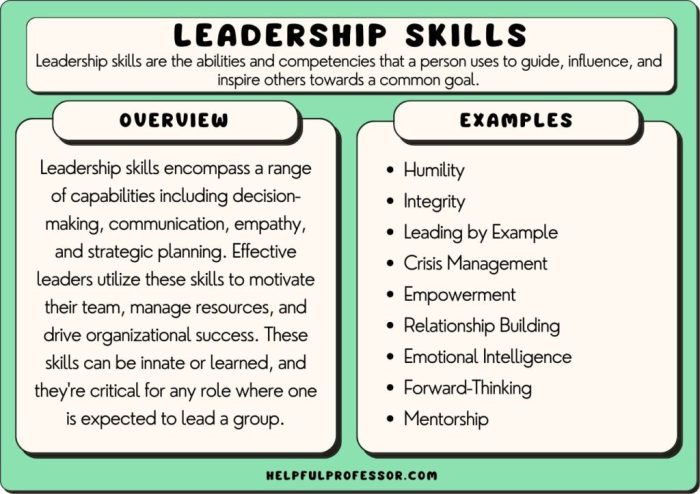
5 reasons why nice leaders run more productive teams: This isn’t about being wishy-washy; it’s about understanding how a supportive, positive approach can actually drive amazing results. A “nice” leader isn’t just friendly; they foster trust, open communication, and a collaborative environment that empowers their teams to thrive. We’ll explore how these seemingly simple leadership styles unlock extraordinary productivity.
This post delves into five key reasons why leaders who prioritize kindness and support often lead to more productive teams. From fostering positive relationships to encouraging innovation, we’ll uncover the surprising power of a friendly approach to leadership.
Defining “Nice” Leadership
“Nice” leadership, while often perceived as a positive trait, requires careful definition to understand its nuances and impact on team productivity. It’s not simply about being friendly or agreeable, but about fostering a supportive and collaborative environment where team members feel valued and empowered. This style emphasizes building trust, open communication, and mutual respect. However, a solely “nice” approach can sometimes fall short of achieving optimal results, and understanding its limitations is crucial for effective application.This style of leadership is characterized by a focus on building strong interpersonal relationships with team members.
It prioritizes empathy, active listening, and fostering a sense of psychological safety where team members feel comfortable expressing their ideas and concerns. “Nice” leaders are often adept at conflict resolution, using a collaborative approach to address disagreements and find mutually beneficial solutions.
Different Facets of “Nice” Leadership Styles
“Nice” leadership encompasses various facets. It’s about more than just being polite; it involves a proactive approach to supporting team members’ professional development, creating opportunities for growth, and providing constructive feedback. It also emphasizes celebrating successes and acknowledging contributions, fostering a positive and motivating team environment.
Examples of “Nice” Leadership Actions and Behaviors
A “nice” leader actively listens to concerns and suggestions, valuing diverse perspectives. They proactively seek input from all team members, ensuring everyone feels heard and respected. When offering feedback, they frame it constructively, focusing on improvement rather than criticism. They celebrate successes and acknowledge individual and team achievements. “Nice” leaders also create a culture of open communication, fostering trust and transparency.
Potential Pitfalls of Overly “Nice” Leadership
While a “nice” leadership approach can be beneficial, an overly “nice” approach can sometimes hinder productivity. This can manifest in avoiding difficult conversations, neglecting to provide clear direction, or failing to hold team members accountable for their performance. This can lead to ambiguity and a lack of clarity, hindering the team’s ability to achieve goals effectively. Overly accommodating a team member might create a sense of entitlement or dependency, preventing growth and independent action.
Comparison with Other Leadership Styles
Comparing “nice” leadership with other styles reveals crucial distinctions. Authoritarian leadership, for example, emphasizes top-down decision-making and strict adherence to rules. Transformational leadership, conversely, focuses on inspiring and motivating team members towards a shared vision. The following table summarizes these distinctions, highlighting strengths and weaknesses in relation to team productivity:
| Leadership Style | Strengths | Weaknesses |
|---|---|---|
| Nice | Fosters strong relationships, high morale, encourages open communication. | May avoid necessary tough conversations, potentially hindering accountability and productivity. |
| Authoritarian | Provides clear direction, efficient in crisis situations. | Can stifle creativity and innovation, lead to resentment and low morale. |
| Transformational | Inspires and motivates, fosters a sense of shared purpose, drives innovation. | Can be less effective in highly structured or routine tasks, requires significant effort to cultivate vision. |
Positive Impact on Team Dynamics
A “nice” leadership style, characterized by empathy, respect, and genuine concern for team members, significantly impacts team dynamics. This approach fosters a positive and supportive environment where individuals feel valued and empowered to contribute their best work. Such a climate is not merely pleasant; it is demonstrably linked to increased productivity and overall team success.This positive impact stems from the cultivation of trust, psychological safety, and open communication, all crucial elements for high-performing teams.
A supportive and inclusive environment built on these foundations elevates motivation and morale, resulting in a more engaged and productive workforce. By prioritizing team well-being, “nice” leaders unlock the collective potential of their teams.
Cultivating Trust and Psychological Safety
Trust is the bedrock of any successful team. “Nice” leaders actively build trust by demonstrating reliability, keeping commitments, and acting with integrity. When team members trust their leader, they are more likely to be open and honest in their communication, reducing the risk of conflict and fostering a collaborative spirit. Psychological safety is equally important. It allows team members to take risks, share ideas, and admit mistakes without fear of judgment or retribution.
This sense of security encourages open communication and the free flow of ideas, critical for problem-solving and innovation.
Promoting Open Communication
Open communication is vital for effective teamwork. “Nice” leaders actively encourage dialogue, ensuring all team members feel comfortable voicing their opinions and concerns. They actively listen to diverse perspectives, demonstrating respect for each individual’s contributions. This creates a culture where feedback is welcomed and used constructively to improve processes and outcomes. By facilitating open dialogue, “nice” leaders create an environment where everyone feels heard and valued, boosting team morale and productivity.
Enhancing Team Cohesion and Support
A supportive and inclusive environment is essential for a team to thrive. “Nice” leaders create a space where every member feels valued and respected, fostering a sense of belonging and mutual support. This inclusivity extends to recognizing individual strengths and providing opportunities for growth and development. Such a supportive atmosphere increases motivation and morale, leading to a more engaged and productive team.
Team-Building Activities
Team-building activities play a crucial role in strengthening relationships and fostering collaboration. “Nice” leaders prioritize activities that encourage interaction, communication, and shared experiences. These activities can range from simple icebreakers to more complex problem-solving exercises. Examples include team lunches, outdoor excursions, volunteer work, or creative problem-solving sessions.
Impact on Team Dynamics: A Summary
| Aspect of Team Dynamics | Impact of “Nice” Leadership |
|---|---|
| Trust | Increased openness, honesty, and collaboration. |
| Psychological Safety | Encourages risk-taking, idea sharing, and constructive feedback. |
| Open Communication | Enhanced dialogue, diverse perspectives, and constructive feedback. |
| Supportive Environment | Increased motivation, morale, and sense of belonging. |
| Team Cohesion | Stronger relationships, shared experiences, and collaborative spirit. |
Improved Communication and Collaboration

A cornerstone of high-performing teams is effective communication. “Nice” leaders understand that open dialogue, active listening, and constructive feedback are essential for fostering a collaborative environment. This positive atmosphere allows for the free flow of ideas, solutions to problems, and ultimately, greater productivity. Teams with strong communication and collaboration are better equipped to tackle challenges and achieve shared goals.”Nice” leadership isn’t about being passive or weak; it’s about being empathetic and understanding, traits that directly translate into better communication and collaboration.
This approach fosters trust and respect, which are the bedrock of productive teamwork. A team that feels safe to share ideas and concerns, and knows they will be heard and valued, will consistently outperform a team that operates in fear or suspicion.
Facilitating Effective Communication
“Nice” leaders actively cultivate a communication-friendly environment. They understand that communication isn’t just about transmitting information; it’s about understanding the nuances of the message and the recipient’s perspective. This involves creating opportunities for team members to share their ideas and concerns without fear of judgment or retribution.
Active Listening and Empathy
Active listening is a critical skill for “nice” leaders. It involves paying close attention not only to the words being spoken but also to the underlying emotions and perspectives. This empathetic approach allows leaders to understand the individual motivations and concerns of team members, leading to more effective solutions and stronger relationships. Empathy allows leaders to tailor their communication style to each team member, creating a more personalized and impactful interaction.
Constructive Feedback and Conflict Resolution
Constructive feedback is an essential tool for growth and improvement. “Nice” leaders use feedback as an opportunity to help team members learn and develop, rather than as a means of criticism or blame. Feedback is delivered with sensitivity, focusing on specific behaviors and their impact, and offering suggestions for improvement. Conflict resolution is approached with empathy and a focus on finding mutually beneficial solutions.
“Nice” leaders view conflicts as opportunities for growth and learning, not as obstacles to be avoided. They facilitate open discussions, encourage active listening from all parties, and guide the team towards a resolution that respects everyone’s perspective. A key element is acknowledging the validity of differing viewpoints.
Promoting Open Dialogue and Knowledge Sharing
Open dialogue is essential for fostering a culture of knowledge sharing. “Nice” leaders create opportunities for team members to share ideas, ask questions, and contribute to the collective knowledge of the team. This could include regular team meetings, brainstorming sessions, knowledge-sharing platforms, or even informal check-ins. The goal is to ensure everyone feels comfortable voicing their opinions and contributing to the team’s overall success.
Leaders can create a safe environment by emphasizing the value of different perspectives and acknowledging the contributions of each team member.
Communication Techniques Used by “Nice” Leaders, 5 reasons why nice leaders run more productive team
| Technique | Description | Example |
|---|---|---|
| Active Listening | Paying close attention to verbal and nonverbal cues, asking clarifying questions, and summarizing to ensure understanding. | “So, if I understand correctly, you’re saying…” |
| Empathetic Communication | Tailoring communication style to understand and acknowledge the emotional context of the message. | “I can see why you might feel that way.” |
| Constructive Feedback | Focusing on specific behaviors and their impact, offering suggestions for improvement, and emphasizing growth. | “I noticed you missed the deadline on the project. Could you tell me what factors contributed to that?” |
| Open-Ended Questions | Encouraging deeper thought and exploration of ideas. | “What are your thoughts on this approach?” |
| Conflict Mediation | Facilitating dialogue between conflicting parties, helping them identify common ground, and finding mutually acceptable solutions. | “Let’s hear both sides of the story before we move forward.” |
Increased Motivation and Engagement
A truly productive team isn’t just about efficiency; it’s about the passion and dedication of its members. “Nice” leadership cultivates a positive work environment that fosters intrinsic motivation, leading to higher engagement and a stronger sense of purpose among team members. This environment is characterized by trust, respect, and a genuine interest in the well-being of each individual.”Nice” leadership doesn’t mean being passive or weak; rather, it emphasizes empathy, active listening, and a proactive approach to supporting team members.
This approach fosters a culture of open communication and collaboration, empowering individuals to contribute their best work and feel valued for their contributions.
Recognition and Appreciation
Recognition and appreciation are cornerstones of motivation. A simple “thank you” or a public acknowledgment for a job well done can significantly impact an individual’s morale and sense of accomplishment. Regular, specific feedback, both positive and constructive, allows team members to understand their strengths and areas for improvement, fostering a sense of growth and development. This type of recognition isn’t just about superficial praise; it’s about demonstrating genuine interest in individual contributions and progress.
So, nice leaders often make for productive teams, right? Five key reasons are that they foster trust and open communication. This positive environment encourages creativity and collaboration. Want to boost your own well-being and maybe even lose some thigh fat? Check out this guide on how to lose thigh fat in 2 weeks.
Ultimately, a positive, supportive atmosphere, like the one a nice leader creates, is essential for a high-performing team. It all comes down to fostering a great environment for success.
For example, a team leader might take the time to acknowledge a team member’s innovative solution during a project review, highlighting its impact on the overall outcome.
Support and Empowerment
Team members thrive when they feel supported and empowered. Providing resources, guidance, and mentorship helps team members navigate challenges and achieve their goals. A “nice” leader understands that support isn’t always about solving problems directly; it’s also about providing the tools and resources necessary for individuals to find their own solutions. This includes delegating tasks appropriately, trusting team members to handle responsibilities, and actively seeking their input.
Nice leaders often foster productive teams because they create a positive work environment. But, how can you build on that positivity and give back? Integrating philanthropy into your business, like exploring opportunities detailed in how add philanthropy your business and create win win , can create a powerful win-win. This shared sense of purpose, in turn, motivates employees and boosts team performance.
Ultimately, these thoughtful leaders inspire a stronger, more productive work environment for everyone.
Empowering team members fosters a sense of ownership and encourages them to take initiative, ultimately leading to more creative and innovative solutions.
Sense of Belonging and Shared Purpose
A strong sense of belonging and shared purpose is crucial for team engagement. Leaders who prioritize building a cohesive team culture foster a sense of community where individuals feel valued, respected, and understood. This can be achieved through regular team-building activities, open communication channels, and creating opportunities for collaboration. Establishing a clear vision and mission, and aligning individual goals with the team’s objectives, creates a shared purpose, uniting the team around a common objective.
Ever wondered why some teams just click? It might be the leader’s approach. Five key reasons nice leaders often build more productive teams, including trust and respect. This links directly to the importance of follow-through, which is crucial for any successful team dynamic. Check out this article on 7 ways always what you say youll 7 ways always what you say youll for more on building that trust.
Ultimately, keeping promises and demonstrating integrity are at the heart of any high-performing team, no matter how nice the leader might be.
This shared purpose fosters a sense of unity and encourages team members to work collaboratively towards a common goal.
Impact Comparison
| Leadership Style | Impact on Individual Motivation | Impact on Team Productivity |
|---|---|---|
| “Nice” Leadership | High motivation due to recognition, support, and empowerment. Increased sense of belonging and shared purpose. | Increased productivity and innovation due to motivated and engaged team members. |
| Authoritarian Leadership | Potentially lower motivation due to lack of recognition and limited empowerment. | Potential for high productivity in the short-term but low innovation and potential for burnout. |
| Laissez-faire Leadership | Potential for decreased motivation due to lack of direction and support. | Potential for low productivity and inconsistent results. |
Enhanced Problem-Solving and Innovation
A “nice” leader fosters a work environment where team members feel safe to voice their opinions and contribute ideas, crucial for effective problem-solving and innovation. This safe space is built on trust and respect, enabling open dialogue and a culture of collaboration. Team members are more likely to share innovative solutions when they feel valued and heard.Open communication and a collaborative atmosphere encourage creative ideas and innovative solutions.
When team members feel comfortable expressing their unique perspectives, the collective intelligence of the team is amplified. This fosters a dynamic where everyone feels empowered to contribute, leading to more creative and effective problem-solving strategies.
Cultivating a Safe Space for Problem-Solving
A key aspect of “nice” leadership is creating a psychological safety net where team members feel comfortable sharing their ideas, even if they’re unconventional or potentially flawed. This safety is fostered by actively listening to all viewpoints, acknowledging diverse perspectives, and refraining from criticism or judgment. Leaders who prioritize understanding over immediate solutions encourage open dialogue and exploration of different approaches, which is essential for generating innovative ideas.
Encouraging Open Dialogue and Creative Ideas
Open dialogue is fundamental to brainstorming and idea generation. “Nice” leaders facilitate this by actively listening to team members, encouraging questions, and creating an environment where diverse viewpoints are welcomed. They acknowledge the value of each person’s contribution, no matter how seemingly small or different. This fosters a culture of mutual respect and trust, which is essential for generating creative ideas and innovative solutions.
Facilitating Brainstorming Sessions and Idea Generation
“Nice” leaders understand the importance of structured brainstorming sessions to generate innovative solutions. They create a supportive atmosphere where team members feel comfortable sharing ideas, even if they seem unconventional. They might use techniques like mind mapping or role-playing to encourage out-of-the-box thinking. A “nice” leader will often encourage active listening, summarizing contributions, and refraining from criticism, allowing for the free flow of ideas.
For instance, a leader might start a session by asking open-ended questions, like “What are some alternative approaches we haven’t considered?” or “How can we reframe this challenge?”
The Role of Diverse Perspectives in Problem-Solving and Innovation
Recognizing and valuing diverse perspectives is critical for successful problem-solving and innovation. Different backgrounds, experiences, and viewpoints bring a unique range of knowledge and insights to the table. “Nice” leaders understand that diverse teams are better equipped to handle complex problems and develop innovative solutions because they bring a broader range of perspectives and experiences to the table.
Teams with diverse members often have more robust and well-rounded approaches to problem-solving.
Steps a “Nice” Leader Takes to Foster Problem-Solving and Innovation
| Step | Action | Rationale |
|---|---|---|
| 1 | Establish a culture of psychological safety. | Team members feel comfortable sharing ideas, even if they are unconventional or potentially flawed. |
| 2 | Actively listen to all team members. | Demonstrate respect for each individual’s contribution. |
| 3 | Encourage open dialogue and diverse perspectives. | Amplify the collective intelligence of the team. |
| 4 | Facilitate brainstorming sessions using techniques like mind mapping or role-playing. | Encourage creative thinking and generate diverse ideas. |
| 5 | Summarize and synthesize ideas to prevent divergence. | Maintain focus and prevent derailment. |
| 6 | Acknowledge and appreciate contributions. | Reinforce the value of each individual’s input. |
Measuring the Productivity Impact
Quantifying the impact of “nice” leadership on team productivity isn’t about vague feelings; it’s about concrete results. A crucial step in demonstrating the value of this leadership style is measuring the resulting productivity gains. This involves a systematic approach to tracking team performance and efficiency, using measurable metrics. This allows for a clear demonstration of the positive correlation between a supportive, collaborative environment and tangible output.Effective leadership, characterized by empathy and respect, fosters an environment where team members feel valued and motivated.
This, in turn, translates into improved performance and productivity, which can be precisely measured. By tracking key metrics, leaders can demonstrate the direct link between their leadership style and the team’s overall success.
Methods for Quantifying Productivity Gains
The methods for quantifying productivity gains from “nice” leadership are varied and involve multiple perspectives. These methods provide a comprehensive understanding of the team’s output and efficiency. Collecting and analyzing data from multiple sources provides a more robust picture.
- Tracking Key Performance Indicators (KPIs): KPIs are specific metrics that quantify a team’s performance. Examples include project completion rates, customer satisfaction scores, error rates, and time-to-market for new products or services. Tracking these metrics over time allows for the identification of trends and patterns.
- Analyzing Team Performance Data: Analyzing data from various sources like project management tools, customer relationship management (CRM) systems, and internal reporting dashboards can reveal insights into team productivity. This detailed analysis often reveals patterns that are not immediately apparent from superficial observation.
- Employee Surveys and Feedback: Regular employee surveys and feedback mechanisms can provide valuable qualitative data. Understanding employee perceptions about their work environment and leadership can help identify areas for improvement and highlight the impact of a “nice” leadership style.
Metrics for Measuring Team Performance and Efficiency
A clear understanding of metrics is critical for measuring team productivity. A variety of metrics, from project completion rates to employee satisfaction, provide a holistic view of team performance.
- Project Completion Rate: This metric tracks the percentage of projects completed within the defined timeframe and budget. A consistent increase in completion rates over time suggests an improvement in team efficiency.
- Customer Satisfaction Scores (CSAT): Measuring customer satisfaction is essential, especially for customer-facing teams. Improved CSAT scores often correlate with increased productivity due to better service delivery and higher customer retention.
- Error Rates: Tracking errors, whether in product development or customer service, is vital. Decreasing error rates indicate a higher level of quality and efficiency in team processes.
- Time-to-Market: In product-oriented teams, the time it takes to bring new products or services to market is a crucial metric. Reducing time-to-market indicates a more streamlined and efficient workflow.
Tracking Key Performance Indicators (KPIs)
Tracking KPIs involves systematically collecting and analyzing data related to specific team objectives. This detailed approach enables a deeper understanding of team dynamics and the impact of leadership style.
- Data Collection Procedures: Implement consistent data collection procedures for all relevant KPIs. This standardization is essential for accurate analysis and comparison.
- Data Analysis Tools: Employ data analysis tools and techniques to identify patterns and trends in the collected data. Visualizations like charts and graphs can make complex data easier to understand.
- Regular Reporting: Regularly report on KPIs to track progress and identify areas requiring attention. Transparency and clear communication about the progress are essential for motivation and alignment.
Analyzing Data to Demonstrate Correlation
Analyzing data to demonstrate a positive correlation between “nice” leadership and productivity requires careful comparison of data sets over time. Identifying trends in performance indicators, in conjunction with leadership changes, allows for a stronger correlation.
| Metric | Description | Measurement Method |
|---|---|---|
| Project Completion Rate | Percentage of projects completed on time | Track project start and end dates, record completion status |
| Customer Satisfaction Score (CSAT) | Average customer satisfaction rating | Collect customer feedback through surveys or feedback forms |
| Error Rate | Number of errors per unit of output | Track errors reported by quality control or customer service |
| Time-to-Market | Time taken to bring a new product or service to market | Track development phases and launch date |
Final Wrap-Up: 5 Reasons Why Nice Leaders Run More Productive Team

In conclusion, a “nice” leadership style, far from being a weakness, is a powerful tool for boosting team productivity. By prioritizing trust, open communication, and a supportive environment, leaders can unlock the full potential of their teams, leading to increased motivation, enhanced problem-solving, and ultimately, greater success. The key takeaway? Nice leaders aren’t just nice; they’re smart leaders who understand the crucial role of positive dynamics in achieving remarkable results.





